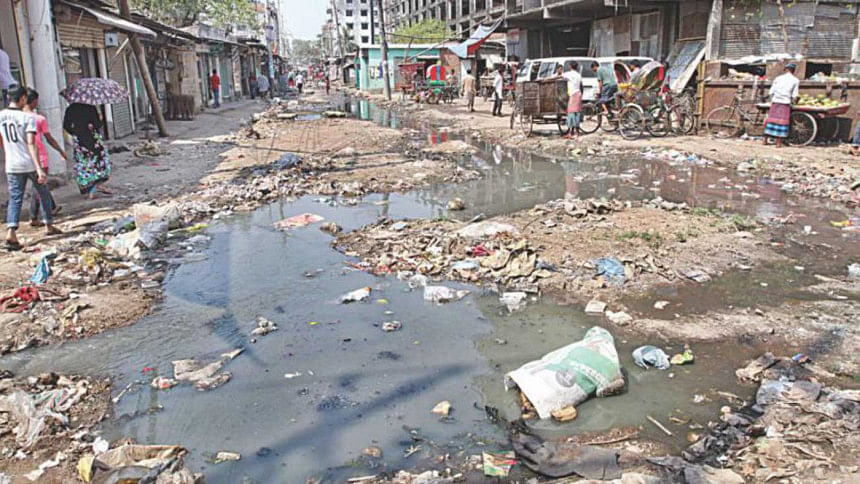Hello mayors, we are still waiting

Do you know the five triggers for happiness? Research shows that exercise, good sleep, shorter commutes, positive relationships with family and friends and connection with nature are essential ingredients that can produce a happy person. The side effects: the more connected we are to family and community, the less likely we are to experience heartaches, strokes, cancer and depression. Well-connected people are said to get better sleep, live longer and are happier persons. Happiness gives rise to economic, social and individual benefits. The happiest cities in the world are those that have outdoor attractions, shopping centres, amusement opportunities and cultural locations.
But our beloved city Dhaka, the capital of Bangladesh, has remained the second liveable city in the world as per Economist's Intelligence unit liveability survey of 148 cities around the world. Our city came second from the bottom of the index in 2014 and 2013 as well. It was rated as the least liveable city in 2012 and the second worst in 2011. Dhaka scored 38.7 out of 100 in critical areas such as healthcare, education, stability, culture and environment as well as infrastructure as per Global Liveability Index 2015. What a shame for all of us. But was Dhaka like this in the past? Not really.
For about 400 years Dhaka was a manageable entity. A complex yet definite grid of river and lakes supplied sweet water to its inhabitants which not only promoted easy trade but also communication. It was a clean, seamless city. It was then called the 'Venice of the East'. During the Mughal times it was a pride of the Empire. It welcomed people from Europe and other parts of the world. In fact like other big metropolis in India, Dhaka accommodated traders and booty hunters from the Netherlands, France and England in large numbers.
Yet Dhaka has a chequered history. From being the capital of Bengal it became a backwater of the British Raj. It was later pronounced as the capital of East Bengal and during the Pakistan days it was the provincial capital of East Pakistan. Then in 1971 it became the capital of independent Bangladesh. And then the dam burst.
Hordes of people from all over Bangladesh swept in the hopes of better fortunes. Crime gangs also perched here for easy pickings. The once serene Dhaka turned into a bustle of markets, schools and universities. The people built shanty towns, large slums and swanking residential areas to accommodate themselves. Dhaka became a gargantuan blot in the world. Since one mayor was unable to control and manage this huge city, two separate mayors were elected to serve the city. Yet neither of the city halls had enough money or staff to manage their areas. Dhaka is now an Armageddon in the making.
But Dhaka needs to resurrect. It is time to rethink the major parameters. It is time to introduce planning and build much of the infrastructure anew. Firstly Dhaka needs better governance; both the city halls need well-financed, manageable governments. They should be equipped with skilled labour and modern machinery. The government should give each of the city halls adequate funds at low interest rates to do their work diligently. The city government cannot stop work under any circumstances and excuse. Cleaning the streets, maintaining parks and collecting garbage should be tasks to be done round the clock. All municipal services should be available at all times. No special interest groups or powerful groups of any hue or colour should be allowed to flout any rule. The people must be given equal access to all municipal laws through the internet and public notices. An independent municipal ombudsman needs to be appointed to see that no injustice is done to anyone. The ombudsman must be swift in dispensing justice and advice.
Dhaka is now the capital of a lower middle income country. As the country's economy grows more money will pour into the city coffers. Flourishing remittance flow, piling of foreign currency reserves and a booming garment sector as well as growth of international investors in FDI will make the availability of funds easier. Dhaka's proximity to the three major powerhouses in the world – China, India and the ASEAN countries – will further push Dhaka to expand. Many state of the art industries are locating in Dhaka. In another ten years, Dhaka would be able to transform itself into a modern city.
Our two mayors need to be visionaries and not just common players. They not only need plans but also money to implement their vision. The upside is that both mayors are young, educated and energetic. To be a city father of a complex and difficult place like Dhaka the mayors cannot afford to be bureaucratic. They need to be super thinkers, planners, go-getters and fixers. Time is not on their side. The people of Dhaka can be patient. But the people are on a short fuse.
....................................................................
The writer is a former Ambassador and a commentator of current affairs.
E-Mail: [email protected]

 For all latest news, follow The Daily Star's Google News channel.
For all latest news, follow The Daily Star's Google News channel. 



Comments